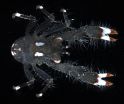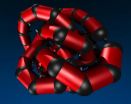(Press-News.org) Pompe disease, a severe glycogen storage disease appearing in Lapphunds is caused by a genetic defect in acid α-glucosidase gene. The same genetic mutation also causes the equivalent disease in humans. Based on this finding, canine Pompe disease can now be diagnosed with a genetic test.
This research was completed at the Canine Genetics Research Group lead by professor Hannes Lohi in the University of Helsinki and Folkhälsan Research Center in Finland and will be published in PLOS ONE on February 14, 2013.
Human Pompe disease is caused by complete or partial deficiency of the acidic α-glucosidase enzyme. In humans, over 300 mutations have been discovered in the gene encoding this enzyme. Pompe disease is recessively inherited, therefore requiring the inheritance of the defected gene from both father and mother. Typically, human patients have two different mutations; one is inherited from father and the other from mother. If both mutations cause severe defect to the enzyme, the enzymatic activity is completely lost. This leads to infantile onset Pompe disease.
The average onset of the infantile disease is before two months of age and the affected children often die before the age of one year. Typical symptoms are floppy appearance, difficulties in sucking and swallowing, an enlarged heart which may lead to heart failure, difficulties in breathing, and respiratory infections. There is no cure for the disease, but enzyme replacement therapy relieves the symptoms and prolongs the patient's lifespan.
Canine Pompe disease is known to occur in Swedish Lapphunds and in this study it was revealed also from Finnish Lapphunds. Both the affected puppies and infantile onset patients lack functional acid α-glucosidase enzyme. Normally this enzyme breaks down the stored glycogen into glucose inside the lysosomes. When the α-glucosidase enzyme is not working properly, glycogen accumulates inside the cells of all tissues. In Pompe disease, glycogen doesn't break down naturally and accumulation most severely affects tissue function of the muscles.
Fast discovery of the gene defect
"From previous studies we knew which enzyme is defective in human patients, so we had a clear candidate gene for our canine studies" states professor Hannes Lohi, the leader of the Canine Genetics Group.
Sequencing the gene from the Finnish Lapphund litter revealed a recessively inherited mutation. This mutation is the same as one of the known 300 mutations in humans. Affected dogs carried two copies of the mutation, the parents were carriers and healthy siblings were either carriers or free of the mutation.
"The effect of the mutation to the gene product is so severe, that although we only had two affected cases in our study, we are certain we have identified the causative mutation" assures the first author of the paper Dr. Eija Seppälä.
The research was carried out in collaboration with Dr. Arnold Reuser who works in the Erasmus MC, Netherlands. With Dr. Reusers' help, a stored cell sample from an affected Swedish Lapphund born already in the 1970s was also tested. This dog was affected by the same mutation as the Finnish Lapphunds.
Finnish Lapphund, Swedish Lapphund and Lapponian Herder have common ancestors from the original reindeer-herding dog population. Therefore one aim was to discover the mutation frequency among current Lapphund and Lapponian Herder populations. A carrier frequency of 5% among Finnish Lapphunds and 2% among Lapponian Herders was revealed by testing approximately 100 dogs from both breeds. In addition, a total of 34 Swedish Lapphunds from Finland, Sweden and Norway were tested. All of these dogs were healthy and did not carry the mutation. It is possible that the sample size was too small for Swedish Lapphund breed and therefore carriers were not detected or it is possible that rigorous breeding program in the 1980s and 1990s has eliminated all the carriers from the current breed.
INFORMATION:
Genetic test: confirmation of the diagnosis and get rid of the disease
The finding of this mutation has made it possible to develop a genetic test for Pompe disease. The genetic test is useful in two ways: it can be used as a diagnostic tool and in screening of the animals used for breeding. The commercial genetic test is offered by Genoscoper Oy.
The same genetic defect causes Pompe disease in both humans and dogs
2013-02-15
ELSE PRESS RELEASES FROM THIS DATE:
The discovery of a new genus of crustacean and 5 new species
2013-02-15
Experts from the Centre for Advanced Studies of Blanes and the University of Barcelona (UB) collected and studied different crustacean specimens during recent expeditions to Madagascar, New Caledonia, Vanuatu, the Philippines and French Polynesia.
Using morphological and molecular data they have discovered five new species of crustaceans in the waters of these regions. They are genetically different but morphologically very similar and they also found a new genus, named Triodonthea. The five new species documented in the study belong to the Lauriea genus of the Galatheidae ...
Force is the key to granular state-shifting
2013-02-15
Ever wonder why sand can both run through an hourglass like a liquid and be solid enough to support buildings? It's because granular materials – like sand or dirt – can change their behavior, or state. Researchers from North Carolina State University have found that the forces individual grains exert on one another are what most affect that transition.
Physicists have explored the changing behavior of granular materials by comparing it to what happens in thermodynamic systems. In a thermodynamic system, you can change the state of a material – like water – from a liquid ...
Chemists develop single molecule sieves to separate complex molecular mixtures
2013-02-15
Chemists at the University of Liverpool have created a new technique that could be used in industry to separate complex organic chemical mixtures.
Chemical feedstocks containing benzene are used extensively in industry to create modern materials and polymers. Their use relies heavily on distillation techniques which separate complex mixtures into more simple molecules used as building blocks to develop drugs, plastics and new materials. These distillation techniques can be expensive and involve large amounts of energy for hard-to-separate mixtures.
A team of researchers ...
Rutgers physicists test highly flexible organic semiconductors
2013-02-15
Organic semiconductors hold promise for making low-cost flexible electronics – conceivably video displays that bend like book pages or roll and unroll like posters, or wearable circuitry sewn into uniforms or athletic wear. Researchers have demonstrated the ability to "print" transistors made of organic crystals on flexible plastic sheets, using technology that resembles inkjet or gravure printing.
However, for the technology's potential to be realized, scientists have to show that these organic semiconductors will withstand the rugged handling they invite – they will ...
Extreme winters impact fish negatively
2013-02-15
Wcologists from Umeå University and the Norwegian University of Science and Technology in Trondheim have studied fish communities and fish habitat and reviewed the importance of winter conditions for fish in streams and rivers in cold regions. The findings are now being published in the journal BioScience.
It is well known that winter can be a stressful season for plants and animals in streams and rivers. It is reasonable to assume that more extreme weather conditions are the most taxing, but the ecological significance of this is poorly understood.
The research team, ...
UC research takes a new approach to identifying 'food deserts'
2013-02-15
University of Cincinnati-led research takes a new direction in examining the availability of healthy foods for urban populations by examining the commuting patterns of its residents.
This new approach to identifying so-called food deserts, now published online, will appear in the May journal of Health and Place.
Neighborhoods without access to stores that provide healthy food options – such as fresh fruits and vegetables – are often labeled as food deserts. However, current methods for determining which neighborhoods have access to nutritious foods focus only on where ...
Nano-machines for 'bionic proteins'
2013-02-15
This press release is available in German.
Physicists of the University of Vienna together with researchers from the University of Natural Resources and Life Sciences Vienna developed nano-machines which recreate principal activities of proteins. They present the first versatile and modular example of a fully artificial protein-mimetic model system, thanks to the Vienna Scientific Cluster (VSC), a high performance computing infrastructure. These "bionic proteins" could play an important role in innovating pharmaceutical research. The results have now been published in ...
Study finds possible link between diabetes and increased risk of heart attack death
2013-02-15
Having diabetes doubles a person's risk of dying after a heart attack, but the reason for the increased risk is not clear. A new University of Iowa study suggests the link may lie in the over-activation of an important heart enzyme, which leads to death of pacemaker cells in the heart, abnormal heart rhythm, and increased risk of sudden death in diabetic mice following a heart attack.
"Many studies have shown that patients with diabetes are at especially high risk for dying from a myocardial infarction (heart attack). Our study provides new evidence that this excess ...
Wild plants are infected with many viruses and still thrive
2013-02-15
UNIVERSITY PARK, PA. -- Researchers have studied viruses as agents of disease in humans, domestic animals and plants, but a study of plant viruses in the wild may point to a more cooperative, benevolent role of the microbe, according to a Penn State virologist.
"Most of these wild plants have viruses," said Marilyn Roossinck, professor of plant pathology and environmental microbiology and biology, who has examined more than 7,000 individual plants for viruses. "But they don't have any of the symptoms that we usually see in crop plants with viruses."
Most of the viruses ...
Technique that removes additional toxins prolongs dialysis patients' lives
2013-02-15
Highlights
A technique that removes additional toxins during dialysis decreased kidney failure patients' risk of dying from any cause by 30% over three years.
The technique also reduced patients' risk of dying from heart-related causes or infections.
15% to 25% of dialysis patients die annually.
Washington, DC (February 14, 2013) — A technique that removes additional toxins during dialysis may prolong kidney failure patients' lives, according to a clinical trial appearing in an upcoming issue of the Journal of the American Society Nephrology (JASN). In light of ...



